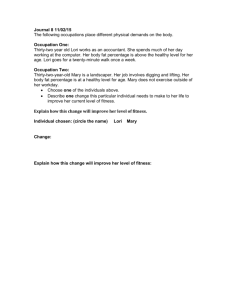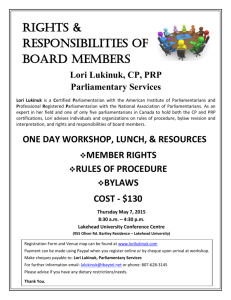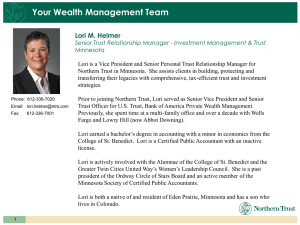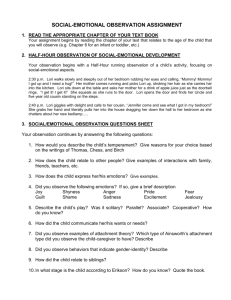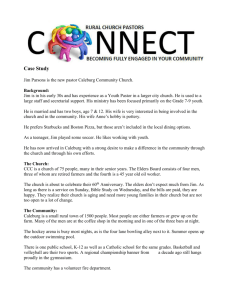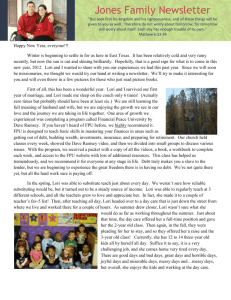Manager T The Well-Practiced Effective Teams
advertisement
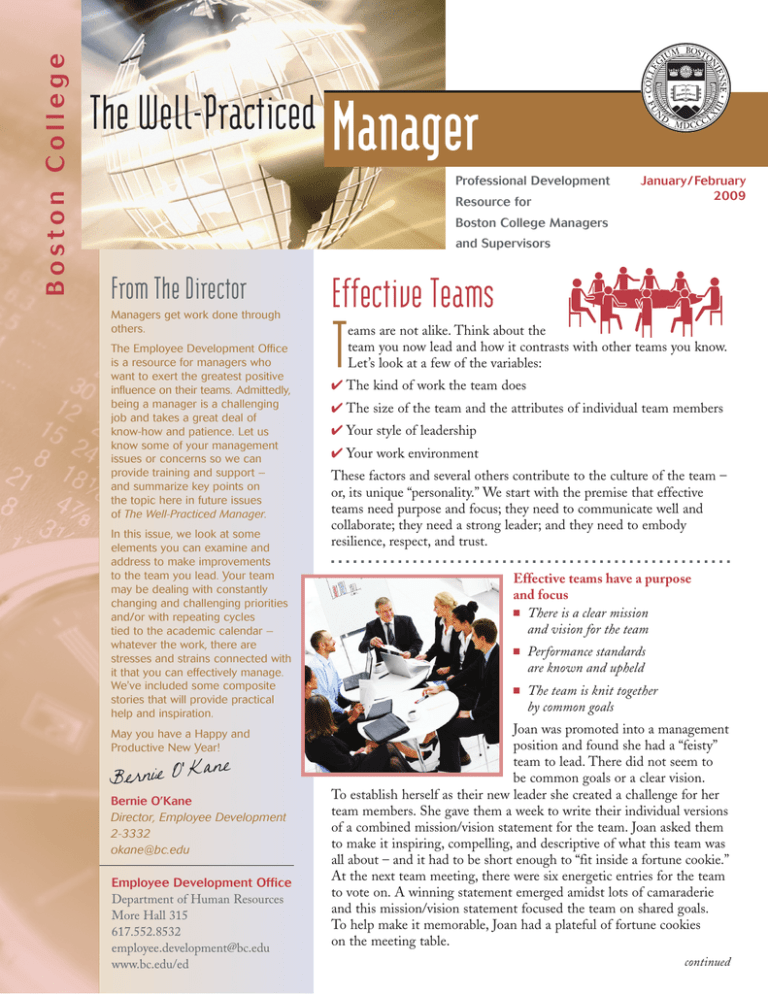
Boston College The Well-Practiced Manager Professional Development January/ February 2009 Resource for Boston College Managers and Supervisors From The Director Managers get work done through others. The Employee Development Office is a resource for managers who want to exert the greatest positive influence on their teams. Admittedly, being a manager is a challenging job and takes a great deal of know-how and patience. Let us know some of your management issues or concerns so we can provide training and support – and summarize key points on the topic here in future issues of The Well-Practiced Manager. In this issue, we look at some elements you can examine and address to make improvements to the team you lead. Your team may be dealing with constantly changing and challenging priorities and/or with repeating cycles tied to the academic calendar – whatever the work, there are stresses and strains connected with it that you can effectively manage. We've included some composite stories that will provide practical help and inspiration. May you have a Happy and Productive New Year! ane Bernie O’K Bernie O’Kane Director, Employee Development 2-3332 okane@bc.edu Employee Development Office Department of Human Resources More Hall 315 617.552.8532 employee.development@bc.edu www.bc.edu/ed Effective Teams T eams are not alike. Think about the team you now lead and how it contrasts with other teams you know. Let’s look at a few of the variables: ✔ The kind of work the team does ✔ The size of the team and the attributes of individual team members ✔ Your style of leadership ✔ Your work environment These factors and several others contribute to the culture of the team – or, its unique “personality.” We start with the premise that effective teams need purpose and focus; they need to communicate well and collaborate; they need a strong leader; and they need to embody resilience, respect, and trust. ■ ■ ■ ■ ■ ■ ■ ■ ■ ■ ■ ■ ■ ■ ■ ■ ■ ■ ■ ■ ■ ■ ■ ■ ■ ■ ■ ■ ■ ■ ■ ■ ■ ■ ■ ■ ■ ■ ■ ■ ■ ■ ■ ■ ■ ■ ■ ■ ■ ■ ■ ■ ■ ■ Effective teams have a purpose and focus ■ There is a clear mission and vision for the team ■ Performance standards are known and upheld ■ The team is knit together by common goals Joan was promoted into a management position and found she had a “feisty” team to lead. There did not seem to be common goals or a clear vision. To establish herself as their new leader she created a challenge for her team members. She gave them a week to write their individual versions of a combined mission/vision statement for the team. Joan asked them to make it inspiring, compelling, and descriptive of what this team was all about – and it had to be short enough to “fit inside a fortune cookie.” At the next team meeting, there were six energetic entries for the team to vote on. A winning statement emerged amidst lots of camaraderie and this mission/vision statement focused the team on shared goals. To help make it memorable, Joan had a plateful of fortune cookies on the meeting table. continued the whole team. She asked three members of her team to work collaboratively on an upcoming six-month project. Cherise explained ■ Disagreement is not a catastrophe the results she wanted at the end of six ■ Listening skills are used months. One of her success measures for the six-month project was evidence Greg’s team meetings were boring. that the three people had successfully No one looked forward to them. collaborated throughout the project. He wanted his meetings to energize She did not select a project leader, but people and tap into their collected did ask for a work plan that would knowledge and expertise. Instead, he show how they would work together had a few individuals who dominated the conversation with negative comments over the next six-month period. Cherise reviewed their plan, gave her approval, and others who were silent and withand delegated the responsibility to the drawn. Greg wanted to ensure that all voices were heard and the potential for team, confident that they now could use their collaborative skills more effectively. synergy was fulfilled. He instituted a “Structured Go-Around” at each team Effective teams have strong leadership meeting, rather than have an open ■ Define a clear path for moving forward discussion period. The “Structured ■ Encourage others Go-Around” ensured that everyone gets equal mike-time and everyone ■ Show you are capable, self-confident, contributes their thoughts and comments and honest on the topic. This simple change helped his team meetings to move from largely Jim’s time was taken up with phone calls and meetings with people outside negative to mostly positive – and to of his department. This left little time send a strong message to his team that for quality conversations with members their full participation is required. of his own team. In truth, he spent little Effective teams work in collaboration time managing others. He managed workflow (or so he thought) but not ■ Willing to work for the good people. Jim believed that hiring good of the whole team people relieved him of the day-to-day ■ Personal agendas are set aside work of managing them. He would say, ■ Individual strengths are confirmed “I step back and let people do the job Cherise had several high achievers and they were hired to do.” When a serious performance problem emerged on no natural collaborators on her team. his team, Jim was the last to know. She saw this as a potential problem, He hadn’t been paying attention to because critical information was not what individuals did or the quality or easily shared with others. Cherise believed that strengthening collaborative timeliness of their work. He was busy elsewhere. The situation escalated into skills on her team would increase the knowledge, expertise, and capability of a very big problem that finally got Jim’s attention and the attention of his own manager who told Jim that “This needs to Teams are not the universal be corrected answer to getting work done. and corrected There are many tasks and fast.” Jim learned a responsibilities that are best done tough lesson solo or with limited input from – but he others. It’s important to distinguish learned it in the difference. Effective teams find a way to effectively communicate ■ Ideas and views are shared Remember: time to change his behavior and – over time – became a strong leader. He realized that time spent talking with members of his team was not only useful, it was essential. He began the habit of scheduling time with individuals and for team meetings BEFORE he filled his day with other meetings and tasks. The situation turned around, just in time. Effective teams are resilient, respectful, and trusting ■ Hardiness and flexibility are demonstrated ■ Courteous behavior and friendly interactions are valued ■ Belief in one another is evident Lori was frustrated that one of the people on her team had a habit of making sarcastic remarks about her peers and others. The comments were borderline – not quite rude, but not complimentary. These remarks usually got a laugh from others, but Lori recognized the potential danger. She took direct action. She talked privately to the employee and said that sarcasm was unwelcome and unacceptable. At her next team meeting, Lori led the group in a discussion about “Group Guidelines” for working together. Lori invited members of the team to suggest ground rules for keeping the workplace friendly and respectful and wrote them on the white board. To go further, Lori added her own suggestion to the list. She wrote: “Make this a sarcasm-free zone.” Lori explained to the team the importance of that guideline. The “Group Guidelines” were turned into a poster that now hangs in the team’s meeting room, reminding everyone of their standards for interactions. ■ ■ ■ ■ ■ ■ ■ ■ ■ ■ ■ ■ ■ ■ ■ ■ ■ ■ ■ ■ Editorial Services provided by Nancy Sartanowicz, Workplace Strategies, www.yourstrategies.com Graphic Design by Tania Fine Helhoski, BirdDesign, www.birddesignstudio.com ■ ■ ■ ■ ■ ■ ■ ■ ■ ■
